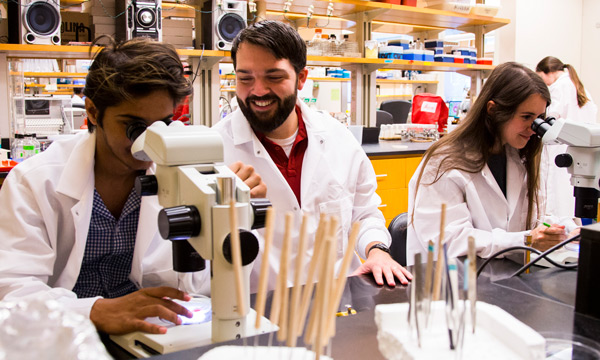Areas of Inquiry
The rapid increase in the size and complexity of population biology datasets require novel tools and improved methods of analysis, visualization and data handling. Developing and critically evaluating these tools and approaches is a core focus of faculty performing research in this area of inquiry. The types of population biology problems addressed are diverse. Some of these include inventing improved methods of genetic mapping for genome-wide association and family-based linkage studies, developing software frameworks for analyzing large genomics datasets, and developing web services to speed genome annotation.
Key Words: array comparative genomic hybridization, bioinformatic software, family-based linkage, genome annotation software, genome-wide association, next-generation sequencing data analysis, spatial statistics, statistical genetics
Interactions between species, whether beneficial or harmful, are ubiquitous in nature. These interactions may include two players (e.g. a host and its bacterial symbiont), multiple players (e.g. butterflies, their larval food plants and protozoan parasites) or an entire community (e.g. plant-pollinator networks at the landscape scale).Faculty performing research in this area use experimental approaches to understand the dynamics of these interactions and the importance of ecological context in shaping these interactions.
We also use genetic and genomic approaches to uncover population structure, molecular mechanisms and genetic variation underlying the traits that shape species interactions. A major aim of our work is to understand how such interactions drive the population dynamics and evolution of the respective species, and we use this biological understanding to apply our work to conservation and management questions in a variety of settings.
Key Words: community ecology, mutualism, parasitism, symbioses
The major focus of disease ecology is to gain a greater understanding of how diseases spread, the interactions between the hosts, pathogens and environment, and ultimately the types of changes observed in natural populations. Faculty performing research in this area use experimental and model-based approaches to address a diverse collection of problems with the goal of gaining a greater understanding of the spatio-temporal dynamics of disease. Problems addressed include the phylogenetic history and origin of pathogens, the population dynamics and control of infectious diseases, and the processes contributing to the evolution of drug resistance.
Key Words: eco-epidemiology, immunity, landscape genetics, molecular epidemiology, vectorborne diseases, virulence evolution, within-host dynamics, zoonotic diseases
Mathematical modeling of complex ecological and evolutionary processes can provide unique insights to biological systems, help elucidate unanticipated processes at work in populations, and provide testable predictions for empirical studies. Building and evaluating such models is central to research in this area of inquiry. Faculty performing research in this area use mathematical models to address a diverse collection of problems. These include within-host dynamics of the immune response, the evolution of drug resistance, models describing the spatial-temporal dynamics of infectious diseases, and dynamics of microbial populations.
Key Words: community ecology, evolution of drug resistance, microbial population dynamics, phylodynamics, spatial dynamics, transmission dynamics, within-host dynamics
Understanding the genetic basis of complex traits is a central challenge in contemporary biology. Research in this area aims to combine the latest genomics technologies with sophisticated statistical models in order to better understand the how genomic variation leads to the phenotypic diversity observed in natural populations. Faculty performing research in this area address a wide variety of problems. These include the nature of complex disease traits in contemporary human populations, the genetic basis of pathogen virulence and toxin resistance, the structure, replication and segregation of chromosomes, and processes contributing to adaptation and reproductive isolation in Drosophila.
Key Words: adaptation, diversification, drosophila genetics, epigenetics, human disease, human genetics, immunity, infectious disease, quantitative genetics, speciation, transcriptome
Characterizing the patterns of genomic variation within and between species is a major goal of this research area. We explore how these data can be used to test evolutionary hypotheses and identify genomic regions with unusual or novel functions. Faculty performing research in this area work in a variety of systems, use the latest next-generation sequencing and genotyping technologies, and analyze data using bioinformatic and computational biology tools.
Key Words: chromosome structure, copy number variation, demographic inference, evolution of gene regulation, genome structure and function, human genomics, insertion-deletion variation, microbial genomics, positive and negative selection, single nucleotide polymorphisms







